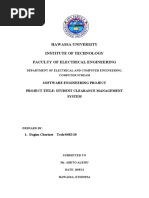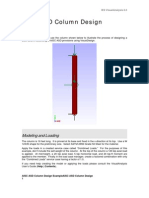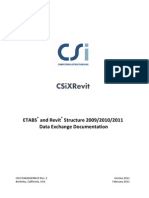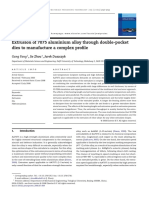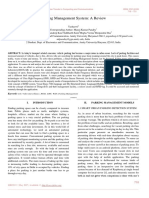Aisc Dam Guide
Aisc Dam Guide
Uploaded by
ScribdmarificCopyright:
Available Formats
Aisc Dam Guide
Aisc Dam Guide
Uploaded by
ScribdmarificCopyright
Available Formats
Share this document
Did you find this document useful?
Is this content inappropriate?
Copyright:
Available Formats
Aisc Dam Guide
Aisc Dam Guide
Uploaded by
ScribdmarificCopyright:
Available Formats
COMPUTERS AND STRUCTURES, INC.
, BERKELEY, CALIFORNIA APRIL 2009
PRACTICAL HOW-TO GUIDE
TECHNICAL NOTE
2005 AISC DIRECT ANALYSIS METHOD
This is a practical how-to guide for using the 2005 AISC Direct Analysis Method (DAM) in SAP2000 and ETABS design. As an alternative to conventional design methods using equivalent length K factors, the DAM is a design procedure for stability analysis that uses K = 1. The DAM eliminates confusion and inconsistency in the application of K factors in conventional design, and may result in a more economical design. Equivalent length alignment charts are based on the often overly conservative assumption of sidesway buckling in a simplified elastic structure, commonly resulting in K factors of 2 to 3 or greater. First, let us review the DAM criteria in Appendix 7 Chapter C. The criteria are provided in boldfaced type. 1. 2. Consider flexural, shear, and axial deformations of members. Those requirements are automatically accounted for in all ETABS and SAP2000 analyses. Reduce member stiffness due to inelasticity, including residual stress, and include the effect of this stiffness reduction in the analysis of the structure. This is completed automatically within SAP2000 and ETABS, except for SAP2000 versions prior to V11.0.7 for which users are required to assign reduction factors using frame property modifier forms. Account for geometric imperfections, such as out-of-plumbness, which SAP2000 and ETABS have automated through their "notional" lateral load case/load pattern definition. (load effects on a structure that has already laterally displaced) and local p-delta effects of loads on the deformed shape of individual members. Both of these requirements are automatically considered in SAP2000 and ETABS p-delta analysis.
3.
4. Perform a rigorous nonlinear p-delta analysis that considers the effects of sway
Introduction
SAP2000 has offered the Direct Analysis Method since V11.0, released in December 2006. ETABS started offering DAM with Version 9.1.6. CSI continually strives to automate the design process for the engineer, and as a result of these efforts, there are some differences in how users approach DAM using our software, depending on the version, and depending on if SAP2000 or ETABS is being used. This guide attempts to point out these differences wherever applicable.
Practical How-To Guide
Page 1 of 12
Practical How-To Guide
2005 AISC Direct Analysis Method
Direct Analysis Method using SAP2000 Version 11.0.7
Specify design code and related design parameters using the Options menu > Preferences > Steel Frame Design command. At a minimum, specify the AISC360-05/IBC2006 code and stiffness reduction method in order to ensure that automatic load combinations are properly generated.
Reduction factors to section EI and EA are automatically applied by the program if the DAM Tau-b variable or Tau-b fixed option is selected. For the initial analysis, no reduction factors are used. However, as soon as a design is run the reduction factors are used and remain in the model. This means that the first time the model is analyzed and designed, users must iterate between design and analysis at least one additional time. Thereafter, both analysis and design will have reduction factors applied automatically. Define notional loads for member geometric imperfections. Use the Define menu > Load Cases command to define gravity load cases (Dead and Live type), then click More under load "Type" to access the Notional load option. It does not matter if lateral loads are defined before or after Notional loads. Give the Notional load a descriptive name and click the Add Load button with default Auto in the Auto Lateral Load column. Then click the Modify Lateral Load button to complete the definition.
Direct Analysis Method using SAP2000 Version 11.0.7
Page 2 of 12
Practical How-To Guide
2005 AISC Direct Analysis Method
Users should define a Notional load for each gravity load in both X and Y lateral directions, and SAP2000 will then automatically generate notional lateral loads based on the specified proportion of the gravity load definitions. The default is to generate 0.002 of the specified gravity load as a notional lateral load (0.003 is required if the user designs using Tau-b fixed). Within the Analysis case definition, a negative multiplier can be subsequently assigned to account for plus and minus directions of the lateral loads. Define nonlinear load combinations. Users can define load combinations using the Define menu > Combinations command. Then select a combo(s) to be converted to nonlinear p-delta and click the Convert Combos to Nonlinear Cases button to automatically convert selected combos into nonlinear p-delta combos. As an alternative to defining load cases manually, SAP2000 will automatically generate Default linear factored load combos when the Add Default Design Combos button is clicked and the Steel Frame design option shown in this screen capture is selected. After reviewing the automatic design combos created by the program, users can then select / highlight combos and convert selected combos to Nonlinear cases as described previously. Make sure the design code is specified as AISC360-05/IBC2006 before using these steps to automatically create design combos. Otherwise, SAP2000 will not create the correct factored load combos because load combos vary among the design codes. When using ASD the AISC360-05/IBC2006 code requires that, for design, the nonlinear p-delta analysis be carried out under 1.6 times the ASD load combinations and the results are
Direct Analysis Method using SAP2000 Version 11.0.7
Page 3 of 12
Practical How-To Guide
2005 AISC Direct Analysis Method
to be divided by 1.6 to obtain the required strengths. The user will need to apply these amplifications and reductions manually by creating separate analysis and design load combinations. Auto-mesh (optional) for creation of additional joints. Although SAP2000 and ETABS automatically consider small pdelta effects, in some cases users may need to add an additional joint between the I and J joints of their frames in a model to match better with some AISC benchmark problems. This is accomplished using the Assign menu > Frame > Automatic Frame mesh command. Use the Minimum Number of Segments option. Specifying two (2) segments is usually adequate. Unless the model is very large, the Automatic frame mesh option should not significantly affect analysis runtime. Note: When importing older SAP2000 models designed with DAM in earlier versions V11.0 through V11.0.6, SAP2000 will automatically reset the reduction factors unless the Options menu > Preferences > Steel Frame Design command is used to select the No modification option for the stiffness reduction method.
Direct Analysis Method using SAP2000 Version 12 and later
The application of the Direct Analysis Method using SAP2000 Version 12 or later is similar to SAP2000 Version 11. The differences are described as follows. Reduction factors to section EI and EA are automatically applied by the program if the DAM Tau-b variable or Tau-b fixed option is selected. For the initial analysis, no reduction factors are used. However, as soon as a design is run the reduction factors are used and remain in the model. This means that the first time the model is analyzed and designed, users must iterate between design and analysis at least one additional time. Thereafter, both analysis and design will have reduction factors automatically applied. Define notional loads for member geometric imperfections. A significant difference in the terminology regarding load patterns, load cases and analysis cases appears in SAP2000 Version 12. In SAP2000 Version 12 or later, Load Patterns are used in lieu of Load Cases and Load Cases are used in lieu of Analysis Cases. Use the Define menu > Load Patterns command to define gravity load cases (Dead and Live type), then click More under load "Type" to access the Notional load pattern option. It does not matter if lateral load patterns are defined before or after Notional load patterns. Give the Notional load pattern a descriptive name and
Direct Analysis Method using SAP2000 Version 11.0.7
Page 4 of 12
Practical How-To Guide
2005 AISC Direct Analysis Method
click the Add New Load Pattern button with default Auto in the Auto Lateral Load Pattern column. Then click the Modify Lateral Load Pattern button, which generates this form that can be used to complete the definition.
Define nonlinear load combinations. Users can define load combinations using the Define menu > Load Combinations command. This form appears:
Then, select a combo and then the Modify/Show button to get this form:
To convert the load combination to a nonlinear p-delta load case, click the Create Nonlinear Load Cases from Combo button. The load combination will be converted into a nonlinear load case as follows:
Direct Analysis Method using SAP2000 Version 11.0.7
Page 5 of 12
Practical How-To Guide
2005 AISC Direct Analysis Method
As an alternative to defining load combinations manually, SAP2000 will automatically generate linear Default Design Load Combinations when the Add Default Design Combos button is clicked and the Steel Frame design option (shown in the form below) is selected. After reviewing the automatic default design combos created by the program, the users can then select the desired combos and convert them to Nonlinear load cases as described previously. Make sure the desired design code is specified, such as AISC360-05/IBC2006 before using these steps to automatically create design combos. Otherwise, SAP2000 will not create the correct factored load combos because load combos vary among the design codes. When using ASD the AISC360-05/IBC2006 code requires that, for design, the nonlinear pdelta analysis is carried out under 1.6 times the ASD load combinations and the results are to be divided by 1.6 to obtain the required strengths. The user will need to apply these amplifications and reductions manually by creating separate analysis and design load combinations.
Direct Analysis Method using SAP2000 Version 11.0.7
Page 6 of 12
Practical How-To Guide
2005 AISC Direct Analysis Method
Direct Analysis Method using ETABS Version 9.1.6
Select design code and related design parameters using the Options menu > Preferences > Steel Frame Design command. At a minimum, select the AISC360-05 design code and the stiffness reduction method before defining load cases, because this will affect program generated default load combinations. Reduction factors to section EI and EA are automatically assigned by the program for Tau-b variable and fixed options. For the initial analysis, no reduction factors are used. However, as soon as design has been run, the reduction factors are used and remain in the model. This means that the first time the model is analyzed and designed, users will have to iterate between design and analysis at least one additional time. Thereafter, both analysis and design will have reduction factors automatically applied and no further iteration will be necessary. Definition of notional loads for member geometric imperfections. Use the Define menu > Load Cases command to define gravity load cases (Dead and Live type), then select the Notional load type. Give the notional load a descriptive name, click the Add Load button with the default Auto in the Auto Lateral Load column, and then click the Modify Lateral Load button. Users should define a notional load for each gravity load case in both X and Y lateral directions and ETABS will then automatically generate Notional lateral loads based on that specified proportion of the gravity load definitions. The default is to generate 0.002 of the specified gravity load case as a notional lateral load case (0.003 is required if designing Tau-b fixed, 0.002 for Tau-b variable). It does not matter if lateral load cases are defined before or after Notional loads, just as long as all gravity loads are defined first. Within the definition process initiated using the Define menu > Load Combinations command, a negative multiplier can be assigned to account for plus and minus directions of the lateral loads in a given combo. If ETABS is allowed to automatically generate load combos, plus and minus lateral load cases will be generated in the load combinations. Nonlinear load combinations are based on a user-specified p-delta case. Go to the Analyze menu > Set Analysis Options command and select the Include P-Delta option shown in the following screen capture to specify p-delta cases.
Direct Analysis Method using ETABS Version 9.1.6
Page 7 of 12
Practical How-To Guide
2005 AISC Direct Analysis Method
Click the Set P-Delta Parameters button to access the following form and define the nonlinear p-delta combo that will be the basis for all other loads and combos. DEAD case 1.2 scale factor and LIVE 1.0 factor would be a good basis for many designs, but you may want to scale them differently, depending on your controlling load combos. If you have more than one DEAD case type, you would probably want to include them in this p-delta combo, with factors of 1.2 each.
ETABS will automatically create factored load combinations based on load types that are applied after that p-delta combo. Alternatively, the Define menu > Load Combinations command can be used to define user custom load combinations. If you defined your own load combos, use the Design menu > Steel Frame Design > Select Design Combo command to access the following form and remove any unwanted default load combinations for design, and replace them with user combinations. If automatic program generated load combinations are used, it is a good idea to review them before design.
Direct Analysis Method using ETABS Version 9.1.6
Page 8 of 12
Practical How-To Guide
2005 AISC Direct Analysis Method
Direct Analysis Method using SAP2000 Versions 11.0 through 11.0.6
Between SAP2000 V11.0 and V11.0.6, the Variable Tau-b option was not automated, even though it appears in the design preferences drop-down options. Users of these versions must use Tau-b fixed. These versions do not automatically reduce section EI or EA. Those values have to be reduced by assigning section property modifiers. Beginning with SAP2000 V11.07 and ETABS V9.1.6, reduction factors are automatically applied to EI and EA in accordance with code for both Tau-b Variable and Tau-b fixed. This means that in Versions 11.0 through V11.0.6 of SAP2000, users must select and assign modifiers to EI and EA to comply with the DAM, whereas starting in V11.0.7 this procedure is automated within the program. This is important to note because starting in SAP2000 V11.0.7/ETABS V9.1.6, any assignment of section property modifiers will be in addition to what the program automatically applies for DAM design. Use the Options menu > Preferences > Steel Frame Design command to specify the design code and related design parameters.
Direct Analysis Method using SAP2000 Versions 11.0 through 11.0.6
Page 9 of 12
Practical How-To Guide Assignment of reduction factors to section EI and EA using V11.0 to V11.06. Users must select frames and assign frame property modifiers to moments of inertia and crosssectional areas of frame members in their models before running the analysis and design. After frames have been selected, use the Assign menu > Frame > Property Modifiers command to assign reduction multipliers to EA and EI in accordance with the code.
2005 AISC Direct Analysis Method
Definition of notional loads to account for member geometric imperfections. Use the Define menu > Load Cases command to define gravity load cases (Dead and Live), then click More under load "Type" to access the Notional load option. Give the Notional load a descriptive name, click the Add Load button with default Auto in the Auto Lateral Load column, then click the Modify Lateral Load button, which generates this form. Users should define a notional load for each gravity load case in both X and Y lateral directions and SAP2000 will then automatically generate notional lateral loads based on that specified proportion of the gravity load definitions. The default is to generate 0.002 of the specified gravity load case as a notional lateral load case, but since SAP2000 versions prior to V11.07 are limited to Tau-b fixed, the code requires generation of notional loads using a 0.003 load ratio, which means that users must change the default. Within the Analysis case definition, a negative multiplier subsequently can be assigned to account for plus and minus directions of the lateral loads. Definition of Analysis Cases and Load combinations. P-delta analysis is nonlinear and must be completed at LRFD load levels. Since SAP2000 does not automatically generate load combinations for nonlinear cases, the way to create nonlinear combos is to use the Define menu > Analysis Cases command. Give the analysis case a name and select Nonlinear for the Analysis type. Then specify p-delta for a Geometric nonlinearity parameter as shown in the following form. As previously stated, SAP2000's p-delta analysis automatically accounts for both sway and local effects. Use the following form to define factored load combinations, including directional plus and minus factors.
Direct Analysis Method using SAP2000 Versions 11.0 through 11.0.6
Page 10 of 12
Practical How-To Guide
2005 AISC Direct Analysis Method
After factored load combinations have been defined within the Analysis cases, next tell SAP2000 that these analysis cases are combinations to be included in the design. Use the Define menu > Combinations command to define each load combination to have one Analysis case "combo". For example, in this screen capture, COMB1 is made up of DESIGNCOMB1 that was defined under Analysis cases. The combination was defined in the Analysis case definition because a nonlinear analysis was being run, and factored loads cannot be properly combined in a nonlinear analysis using linear algebraic summation.
Direct Analysis Method using SAP2000 Versions 11.0 through 11.0.6
Page 11 of 12
Practical How-To Guide
2005 AISC Direct Analysis Method
After defining load combinations, specify which load combinations are to be used by SAP2000 for design. Click the Design menu > Steel Fame Design > Select Design Combos command. Remove any default load combos in the "Design combos" list and add the userdefined combination for the design.
Auto-mesh (optional) for creation of additional joints. Although SAP2000 and ETABS automatically consider local pdelta effects, in some cases users may need to add an additional joint between the I and J joints of the frames in a model. Users can easily do this without dividing their frames into multiple segments by selecting columns only or by selecting the entire model and then the Assign menu > Frame > Automatic Frame Mesh command. Use the "Minimum number of segments" options and type 2 in the edit box. SAP2000 and ETABS will internally add an intermediate joint on each selected frame element for analysis, but reformulate the elements in the results so that they are reported and designed as singular objects. We have had excellent correlation on AISC benchmarks without adding joints, but in a few cases it was necessary to add 1 intermediate joint to match perfectly. In very large models, these additional auto-mesh joints may add to runtime, but in most structures the increased runtime will be negligible.
Direct Analysis Method using SAP2000 Versions 11.0 through 11.0.6
Page 12 of 12
You might also like
- Certified Solidworks Professional Advanced Weldments Exam PreparationFrom EverandCertified Solidworks Professional Advanced Weldments Exam Preparation5/5 (2)
- Introduction to the simulation of power plants for EBSILON®Professional Version 15From EverandIntroduction to the simulation of power plants for EBSILON®Professional Version 15No ratings yet
- Hawassa University Institute of Technology Faculty of Electrical Engineering80% (5)Hawassa University Institute of Technology Faculty of Electrical Engineering22 pages
- AutoCAD Electrical 2017 for Electrical Control Designers, 8th EditionFrom EverandAutoCAD Electrical 2017 for Electrical Control Designers, 8th Edition3/5 (1)
- Manual de Diseño de Elemento Metálicos Según SFD-AISC-360-05No ratings yetManual de Diseño de Elemento Metálicos Según SFD-AISC-360-05209 pages
- ACI Concrete Beam Design: Building The ModelNo ratings yetACI Concrete Beam Design: Building The Model6 pages
- RM Bridge CONNECT Edition V11 Update 8 Release Notes (May 2020)No ratings yetRM Bridge CONNECT Edition V11 Update 8 Release Notes (May 2020)21 pages
- CAESAR II - User's Guide Building Static Load Cases100% (1)CAESAR II - User's Guide Building Static Load Cases22 pages
- Dynamic Analysis - Mode Shape Extraction TRNC03058-10001No ratings yetDynamic Analysis - Mode Shape Extraction TRNC03058-1000119 pages
- Analysis and Design Method of Structures Using Tension-Only ElementsNo ratings yetAnalysis and Design Method of Structures Using Tension-Only Elements15 pages
- Designing Steel Structures For Deflection - TRNC03044No ratings yetDesigning Steel Structures For Deflection - TRNC0304436 pages
- Composite Column Design Manual: AISC 360-10100% (2)Composite Column Design Manual: AISC 360-1097 pages
- Tutorial 1: Significant Features of Model and SAP2000No ratings yetTutorial 1: Significant Features of Model and SAP200044 pages
- Technical Note No. TN S02 Second Order Effects PDFNo ratings yetTechnical Note No. TN S02 Second Order Effects PDF9 pages
- Technical Note No. TN S02 Second Order Effects Safe and EtabsNo ratings yetTechnical Note No. TN S02 Second Order Effects Safe and Etabs9 pages
- STAAD Document On Pushover Analysis PDFNo ratings yetSTAAD Document On Pushover Analysis PDF16 pages
- MOTOR SIZING TOOL VERSION 1.5.15 Version HistoryNo ratings yetMOTOR SIZING TOOL VERSION 1.5.15 Version History27 pages
- What's New in CAESAR II: Technical ChangesNo ratings yetWhat's New in CAESAR II: Technical Changes3 pages
- Solidworks 2018 Learn by Doing - Part 3: DimXpert and RenderingFrom EverandSolidworks 2018 Learn by Doing - Part 3: DimXpert and RenderingNo ratings yet
- CSI Etabs To Revit Structure Data Excahge Manual CCNo ratings yetCSI Etabs To Revit Structure Data Excahge Manual CC48 pages
- ETABS-Example-RC Building Seismic Load - Time History100% (15)ETABS-Example-RC Building Seismic Load - Time History59 pages
- Guide Specification For Spun, Prestressed Concrete Poles and Concrete Pole Structures100% (3)Guide Specification For Spun, Prestressed Concrete Poles and Concrete Pole Structures55 pages
- Annaite Tire Co., Limited: Home Product About Contact Company Show SolutionNo ratings yetAnnaite Tire Co., Limited: Home Product About Contact Company Show Solution2 pages
- Questão Do Batismo - Salomão L. Ginsburg by Memória Dos Batistas - IssuuNo ratings yetQuestão Do Batismo - Salomão L. Ginsburg by Memória Dos Batistas - Issuu1 page
- Modeling and Rendering Escher-Like Impossible Scenes: ForumNo ratings yetModeling and Rendering Escher-Like Impossible Scenes: Forum7 pages
- Class 6-Second Assessment Block Test Syllabus - 03-08-2019-1 PDFNo ratings yetClass 6-Second Assessment Block Test Syllabus - 03-08-2019-1 PDF5 pages
- Standards of ResidentialNon ResidentialNo ratings yetStandards of ResidentialNon Residential61 pages
- 2009 - Extrusion of 7075 Aluminium Alloy Through Double-Pocket Dies To Manufacture A Complex ProfileNo ratings yet2009 - Extrusion of 7075 Aluminium Alloy Through Double-Pocket Dies To Manufacture A Complex Profile10 pages
- Collision Risk Management With Simplified ARPA and DSC/AIS InformationNo ratings yetCollision Risk Management With Simplified ARPA and DSC/AIS Information4 pages
- Analysis and Design of Prestressed Precast Hollow Core Slabs Using Strut and Tie Method PDFNo ratings yetAnalysis and Design of Prestressed Precast Hollow Core Slabs Using Strut and Tie Method PDF12 pages
- Chanpreet Singh: Education Work ExperienceNo ratings yetChanpreet Singh: Education Work Experience2 pages
- Certified Solidworks Professional Advanced Weldments Exam PreparationFrom EverandCertified Solidworks Professional Advanced Weldments Exam Preparation
- SAP Variant Configuration: Your Successful Guide to ModelingFrom EverandSAP Variant Configuration: Your Successful Guide to Modeling
- Introduction to the simulation of power plants for EBSILON®Professional Version 15From EverandIntroduction to the simulation of power plants for EBSILON®Professional Version 15
- Hawassa University Institute of Technology Faculty of Electrical EngineeringHawassa University Institute of Technology Faculty of Electrical Engineering
- AutoCAD Electrical 2017 for Electrical Control Designers, 8th EditionFrom EverandAutoCAD Electrical 2017 for Electrical Control Designers, 8th Edition
- Manual de Diseño de Elemento Metálicos Según SFD-AISC-360-05Manual de Diseño de Elemento Metálicos Según SFD-AISC-360-05
- RM Bridge CONNECT Edition V11 Update 8 Release Notes (May 2020)RM Bridge CONNECT Edition V11 Update 8 Release Notes (May 2020)
- CAESAR II - User's Guide Building Static Load CasesCAESAR II - User's Guide Building Static Load Cases
- Dynamic Analysis - Mode Shape Extraction TRNC03058-10001Dynamic Analysis - Mode Shape Extraction TRNC03058-10001
- Analysis and Design Method of Structures Using Tension-Only ElementsAnalysis and Design Method of Structures Using Tension-Only Elements
- Designing Steel Structures For Deflection - TRNC03044Designing Steel Structures For Deflection - TRNC03044
- Tutorial 1: Significant Features of Model and SAP2000Tutorial 1: Significant Features of Model and SAP2000
- Technical Note No. TN S02 Second Order Effects PDFTechnical Note No. TN S02 Second Order Effects PDF
- Technical Note No. TN S02 Second Order Effects Safe and EtabsTechnical Note No. TN S02 Second Order Effects Safe and Etabs
- SolidWorks 2016 Learn by doing 2016 - Part 3From EverandSolidWorks 2016 Learn by doing 2016 - Part 3
- Solidworks 2018 Learn by Doing - Part 3: DimXpert and RenderingFrom EverandSolidworks 2018 Learn by Doing - Part 3: DimXpert and Rendering
- SolidWorks 2015 Learn by doing-Part 3 (DimXpert and Rendering)From EverandSolidWorks 2015 Learn by doing-Part 3 (DimXpert and Rendering)
- Computer Aided Design of Electrical MachinesFrom EverandComputer Aided Design of Electrical Machines
- CSI Etabs To Revit Structure Data Excahge Manual CCCSI Etabs To Revit Structure Data Excahge Manual CC
- ETABS-Example-RC Building Seismic Load - Time HistoryETABS-Example-RC Building Seismic Load - Time History
- Guide Specification For Spun, Prestressed Concrete Poles and Concrete Pole StructuresGuide Specification For Spun, Prestressed Concrete Poles and Concrete Pole Structures
- Annaite Tire Co., Limited: Home Product About Contact Company Show SolutionAnnaite Tire Co., Limited: Home Product About Contact Company Show Solution
- Questão Do Batismo - Salomão L. Ginsburg by Memória Dos Batistas - IssuuQuestão Do Batismo - Salomão L. Ginsburg by Memória Dos Batistas - Issuu
- Modeling and Rendering Escher-Like Impossible Scenes: ForumModeling and Rendering Escher-Like Impossible Scenes: Forum
- Class 6-Second Assessment Block Test Syllabus - 03-08-2019-1 PDFClass 6-Second Assessment Block Test Syllabus - 03-08-2019-1 PDF
- 2009 - Extrusion of 7075 Aluminium Alloy Through Double-Pocket Dies To Manufacture A Complex Profile2009 - Extrusion of 7075 Aluminium Alloy Through Double-Pocket Dies To Manufacture A Complex Profile
- Collision Risk Management With Simplified ARPA and DSC/AIS InformationCollision Risk Management With Simplified ARPA and DSC/AIS Information
- Analysis and Design of Prestressed Precast Hollow Core Slabs Using Strut and Tie Method PDFAnalysis and Design of Prestressed Precast Hollow Core Slabs Using Strut and Tie Method PDF





